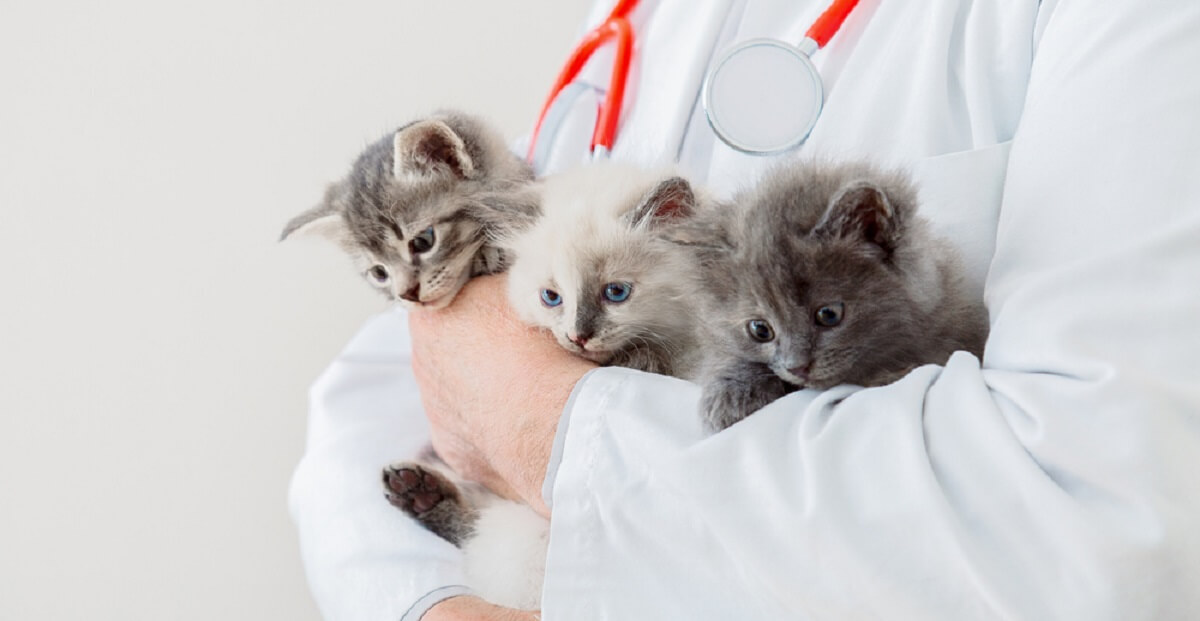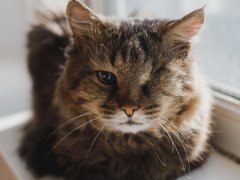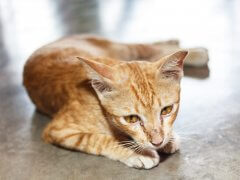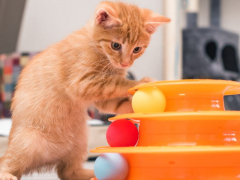What Is Feline Immunodeficiency Virus (FIV)?
FIV virus, is the abbreviation for Feline Immunodeficiency Virus. This is the pathogen which causes Feline AIDS, which is the abbreviation for Feline Acquired Immune Deficiency Syndrome. There are parallels with Human Immunodeficiency Virus (HIV) causing AIDS in humans.
Quick Overview: Feline Immunodeficiency Virus (FIV) In Cats
How Common Is FIV?
FIVs common all around the world, but the precise prevalence varies from location to location. For example in a 2017 study of domestic cats in USA and Canada, 3.6% of cats were positive.
One of the significant reasons for variation in the prevalence rate of FIV in different studies, is that cats that present as sick animals have a higher chance of being FIV positive (e.g. in the 2017 study, nearly 10% of cats with oral disease were FIV positive).
Also Read: What To Know When Adopting A FIV-Positive Cat
Similarly, in the UK, between three to six percent of healthy cats are positive, while sick cats tested while visiting vet clinics have a higher prevalence of 12 -18%.
FIV infection is more common in intact (uncastrated) male cats that have a history of deep bite wounds or abscesses, or that spend time outside.
What Causes FIV Infection?
Feline Immunodeficiency Virus (FIV) is a retrovirus, belonging to the lentivirus genus. The virus causes generalised immunosuppression, with depletion of specific white blood cells (T-helper cells), having a strong negative impact on the cat’s immune system, which causes a range of different signs of illness.
How Is FIV Transmitted?
Cat bites are the primary mode of transmission: FIV virus is mainly passed from cat to cat in the saliva via bite wounds. The virus may also be transmitted from pregnant females to their offspring in the womb, or in early life from mother to kitten via the milk.
Rarely, infection may transmit between two cats in the same household that have no history of fighting or biting each other, suggesting that the virus may, rarely, be passed on by activities like mutual grooming.
Is the FIV Contagious to Humans?
No. FIV and HIV (the cause of Human AIDS) are both lentiviruses, but the viruses are species-specific. Humans cannot be infected by FIV, and cats cannot be infected by HIV.
What Are the Symptoms Caused by FIV?
Infection with FIV causes the syndrome known as “Feline AIDS”, and the clinical signs are caused by immunosuppression, significantly reducing an infected cat’s immune response, which then allows secondary infection by other disease causing agents.
Typical early symptoms include lethargy, inappetence, fever, and lymphadenopathy (enlarged lymph nodes). In the later stages of the disease a range of serious signs of disease are seen, including gingivitis and stomatitis (inflammation of the gums and the oral cavity), with halitosis, drooling and pain when eating, weight loss, abscesses, respiratory signs (such as wheezing and dyspnea), neurological signs (such as behavioral changes and seizures), ocular signs, digestive disorders, and other intercurrent infections.
How Is FIV Infection Diagnosed?
Most tests that are carried out in-house by veterinarians are antibody tests, based on enzyme-linked immunosorbent assay (ELISA) or immunochromatographic (IC) techniques to detect FIV antibodies.
These tests are accurate, with high specificity and sensitivity. They can be processed rapidly, with the cat carer often waiting to hear the result within minutes. Often combination tests are used, with the blood sample being checked for Feline Leukemia Virus (FeLV) at the same time as FIV, which makes logical sense since the signs of both viral infections can be similar.
The rate of false positive is very low.
Positive results may be followed up by sending samples to external laboratories which offer more specialised tests. These are often used to doubly confirm a positive or negative diagnosis: these include immunofluorescence (IFA) and western blot tests for the detection of antibodies to FIV, and virus isolation and polymerase chain reaction (PCR) for the detection of the virus itself.
Virus isolation is sensitive but needs specialised facilities, making it costly and slow compared to other diagnostic tests, so it’s rarely used.
PCR tests are now widely available, detecting the FIV nucleic acids. These are especially useful in the diagnosis of FIV infection in young kittens where antibodies derived from the infected mother cat may interfere with tests that use antibodies to make the diagnosis.
It is important to remember that a positive test result does not mean that a cat needs to be euthanased: many positive cats go on to live for nearly as long as uninfected cats. Only a proportion of FIV positive cats to on to develop acquired immunodeficiency syndrome (AIDS).
Cat FIV Stages
The average life expectancy is 5-6 years from the time of diagnosis.
There are three stages of progression in the cat’s body that follow FIV infection.
- The primary phase: the first two to four months after infection with the virus. Some infected cats are asymptomatic, while other FIV cats show short-term signs of illness involving malaise, pyrexia and possibly generalised lymph node enlargement. Most FIV positive cats recover from this early phase.
- The second phase, sometimes known as the latent stage: cats show no signs of illness. living healthy lives for months or years.
- The third phase, known as the Feline Acquired Immunodeficiency Disease stage (FAIDS) : the signs shown may depend on where in the cat’s body the virus is active. Infection of the nervous system can lead to neurological signs or behavior change, while infection of the digestive system can lead to chronic diarrhoea. The most prominent signs are usually linked to the overall immunodeficiency caused by the virus, with signs including weight loss, inappetence, fever, lymphadenopathy (enlarged lymph nodes) and gingivitis (inflammation of the gums). Other typical problems include upper respiratory tract signs such as rhinitis (inflammation of the lining of the nose) and conjunctivitis (inflammation of the lining of the eye), as well as repeated problems with skin infections. Affected cats are also at a higher risk of developing cancer (e.g. lymphoma) as well as multiple other infections that would not cause significant problems in cats with healthy immune systems.
How Long Do Cats Live With FIV Infection?
The prognosis for cats that are FIV positive, but without showing signs of illness, can be very good, with some cats living for almost as long as cats that are FIV negative.
However cats that develop Feline AIDS, with severe signs of disease, have a poorer prognosis. Their remaining lifespan may be just a few months, but with the right treatment, this may be extended to a number of years.
How To Treat FIV Infection
A cat does not need treatment just because he or she is FIV positive: treatment is only needed if the cat falls will with signs of Feline AIDS. In such cases, cat carers should work closely with their DVM veterinarian to devise an individualised treatment strategy.
Some of the following treatments may be used.
- Zidovudine (AZT) blocks the viral reverse transcriptase enzyme, inhibiting infection of new cells with the virus, but it cannot decrease viral multiplication in cells that are already infected. AZT is most useful as a way of preventing cats from developing full scale Feline AIDS, as well as for treating cats with neurologic disease or gingivostomatitis.
- Interferon has been used, with its immunomodulatory and antiviral effects improving survival rates in some studies, while other studies have had less convincing results.
- Lymphocyte T cell immune modulator (LTCI) stimulates the immune system and may be able to improve clinical signs and reduce the viral burden in affected cats.
- Insulin, administered intra-nasally, has been linked to improvement in some cats affected with neurological signs of Feline AIDS.
- General supportive therapy has a strong role to play, using antibiotics for bacterial infections, avoiding immunosuppressive medication like glucocorticoids, and perhaps erythropoetin to stimulate red blood cell production in cats that are anaemic. Blood transfusions may also be recommended in some cases.
- Ultimately, euthanasia may be recommended for an FIV positive cat that is suffering from severe signs of illness caused by Feline AIDS. It is important to allow a cat a peaceful death when their quality of life is severely diminished by the illness.
How To Prevent FIV Infection
Indoor cats, kept as single pets, have no risk of picking up FIV, so keeping a cat indoors is the most obvious way to prevent FIV.
Neutering plays a role in prevention, as neutered male cats are 80% less likely to fight compared to entire male cats. Spread of FIV is by direct cat to cat contact by fighting, rather than via the environment (e.g. via food bowls or a litter box) or aerosols.
The FIV virus is easily destroyed using common detergents and disinfectants, and it does not live for long in the environment.
If a new cat is introduced to a household, it makes sense to carry out an FIV test first.
Cats that are known to be FIV positive should be kept indoors to prevent spread of infection to other cats, as well as to reduce exposure of themselves to other infectious diseases.
Effective parasite control, regular vaccination and high quality nutrition are all important to reduce the onset of signs linked to a poor immune system.
FIV Vaccine
A whole virus, adjuvant vaccine against FIV is licensed in the United States. This vaccine contains inactivated subtypes A and D. Efficacy is variable. The vaccine does not contain subtype B, which is one of the predominant subtypes found in the USA. Inconsistent results have been found in challenge studies.
The FIV vaccine is considered a non-core vaccine by the American Association of Feline Practitioners (AAFP) and may be reserved for cats with at-risk lifestyles (e.g. those living with FIV-positive housemates, or outdoor cats that are prone to fighting).
Cats over two months of age can be vaccinated, using two doses given subcutaneously 2-3 weeks apart, followed by annual booster vaccinations. Cats vaccinated with the FIV vaccine will test positive for FIV on blood tests, so they need to be clearly identified (eg with a microchip) so that it is known that they are vaccinated, and they are not mistaken as being FIV positive due to virus exposure.
Conclusion
FIV virus causes Feline AIDS, which is a complex disease which is now well understood. The diagnosis of an FIV positive blood test is no longer a reason to euthanase a healthy cat, as many FIV positive cats can have long and healthy lives.
Frequently Asked Questions
Can dogs get feline immunodeficiency virus
FIV is a species-specific virus, which means that dogs cannot become infected with FIV.
Can feline immunodeficiency virus infect humans
FIV is a species-specific virus, which means that humans cannot become infected with FIV.
Can humans get feline herpesvirus
Feline herpes virus is also a species specific virus, so humans cannot become infected.
How do cats get feline immunodeficiency virus
FIV virus is usually passed from cat to cat in the saliva via bite wounds.
The virus may also be transmitted from pregnant females to their offspring in the womb, or in early life from mother to kitten via the milk.
Rarely, infection may transmit between two cats in the same household that have no history of fighting or biting each other.










